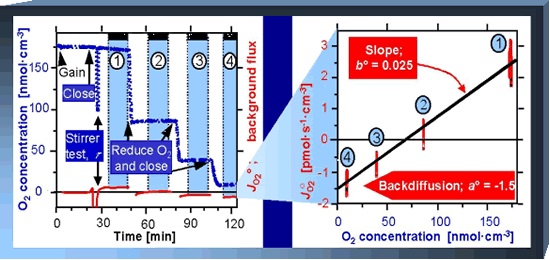MiPNet14.06 Instrumental O2 background
| O2k Quality Control 2: Instrumental oxygen background correction and accuracy of oxygen flux. »Bioblast pdf« |
» ![]() » Versions
» Versions
OROBOROS (2016-02-09) Mitochondr Physiol Network
Abstract: Fasching M, Gnaiger E (2016) O2k Quality Control 2: Instrumental oxygen background correction and accuracy of oxygen flux. Mitochondr Physiol Network 14.6(05):1-8.
O2k-Protocols SOP: Correction for instrumental background oxygen flux is a standard in high-resolution respirometry, automatically performed by DatLab. Background measurements provide a test of instrument function. In the OROBOROS O2k, background corrections are usually within a few % of experimental flux over the entire experimental oxygen range. At minimum activities, however, even the small background effects become highly significant and require compliance to standard operating procedures (O2k-SOP)described in this chapter as part of the MitoFit Quality Control System. This is part 2 of O2k Quality Control.
- » O2k-Protocols SOP: O2k Quality Control 1 »MiPNet06.03 POS-Calibration-SOP«
- » O2k-Manual »MiPNet19.18E O2 Flux Analysis«
- » Product: OROBOROS O2k, O2k-Catalogue
• Keywords: Instrumental background
• O2k-Network Lab: AT_Innsbruck_OROBOROS
Labels: MiParea: Respiration, Instruments;methods
HRR: Oxygraph-2k, O2k-Protocol
O2k-SOP, DatLab
MitoPedia O2k and high-resolution respirometry:
O2k-Open Support
Autoxidation of ascorbate and TMPD causes a chemical background oxygen flux. DatLab provides on-line correction for instrumental and chemical background.
>> Excel Templates and DatLab-Demo Files
Instrumental oxygen background test for permeabilized muscle fibres
Extended instrumental oxygen background test
- While biopsy sampling and fibre preparation proceed: Air calibration in MiR06Cr, then close the chamber to evaluate instrumental background at air saturation (c. 10 min): This is a quality control of the medium, important under field conditions, where medium preservation (sterility) may be less controlled than in the lab.
- Elevate oxygen concentration to 450 µM with oxygen gas (Syringe\60 ml\Gas-Injection), close and after two to three min perform a stirrer test (the new DatLab has an automatic stirrer test function, with defined duriation of stopping the stirrer and automatic restart of stirring, 40 s stirrer stop may be optimum). This is important, since the OroboPOS may have a different response time at elevated oxygen concentration. If the response time increases dramatically, then the sensor may even show a non-linear response to oxygen concentration at high oxygen levels.
- Instrumental background: After 20 min, open the chamber and allow O2 to drop to c. 350 µM, close for 20 min, open and drop O2 to c. 250 µM (this should be the lowest experimental O2 concentration).
- Increase O2 with H2O2 injection (c. 2 µl) to 400 µM, measure for 15-20 min instrumental background, simulating a re-oxygenation during the experiment.
- Increase O2 with H2O2 injection (c. 1 µl) to 450 µM, until the fibres are added, for equilibrating the instrument at high O2.
- Addition of permeabilized fibres into the O2k-Chamber: >> Permeabilized muscle fibres.
Flux in closed chamber near air saturation (in preparation)
The oxygen flux in a closed chamber at air-calibrated oxygen concentration is an important control parameter. It reflects the consumption of oxygen by the polarographic oxygen sensor (POS). The theoretical value is calculated by DatLab in the O2 Calibration window (Details tab/ Oxygen consumption by POS), see Supplement C in MiPNet06.03 POS-Calibration-SOP. The theoretical value at 37°C (O2 slope uncorrected) is usually between 2 and 3 pmol·s-1·ml-1. The actual values should be within ± 1 pmol/(s·ml). Values higher than 4-5 pmol·s-1·ml-1 at 37° may therefore indicate a biological contamination in the chamber or in the medium (but double check the theoretical value from the Details tab). Lower values may indicate:
- a higher chamber volume: check and if necessary repeat chamber volume calibration
- air bubbles: remove air bubbles
- if a multi-sensor stopper with multiple bores is used: liquid on top of the stopper creating an exchange of liquid between the chamber volume and the outside: aspirate excess liquid from top of stopper
For different fluxes in the left and right chamber (with or without sample) see also Different O2 fluxes in left and right chamber
Further information
References



